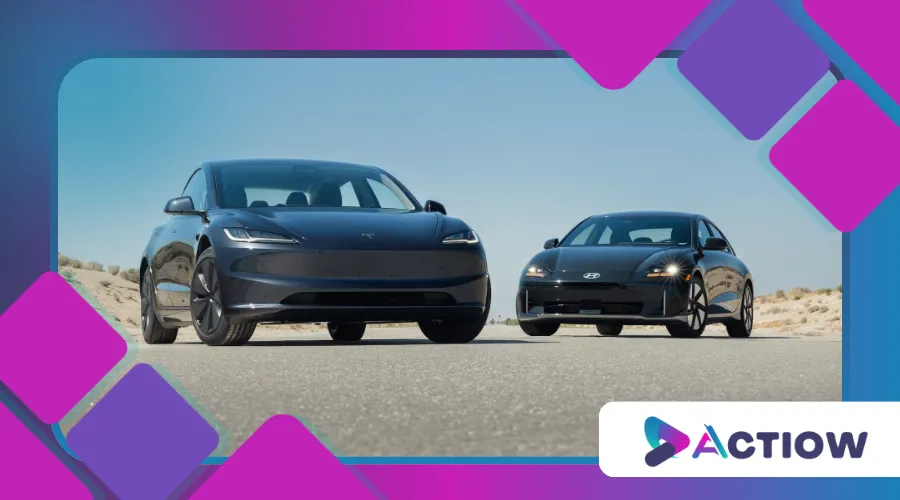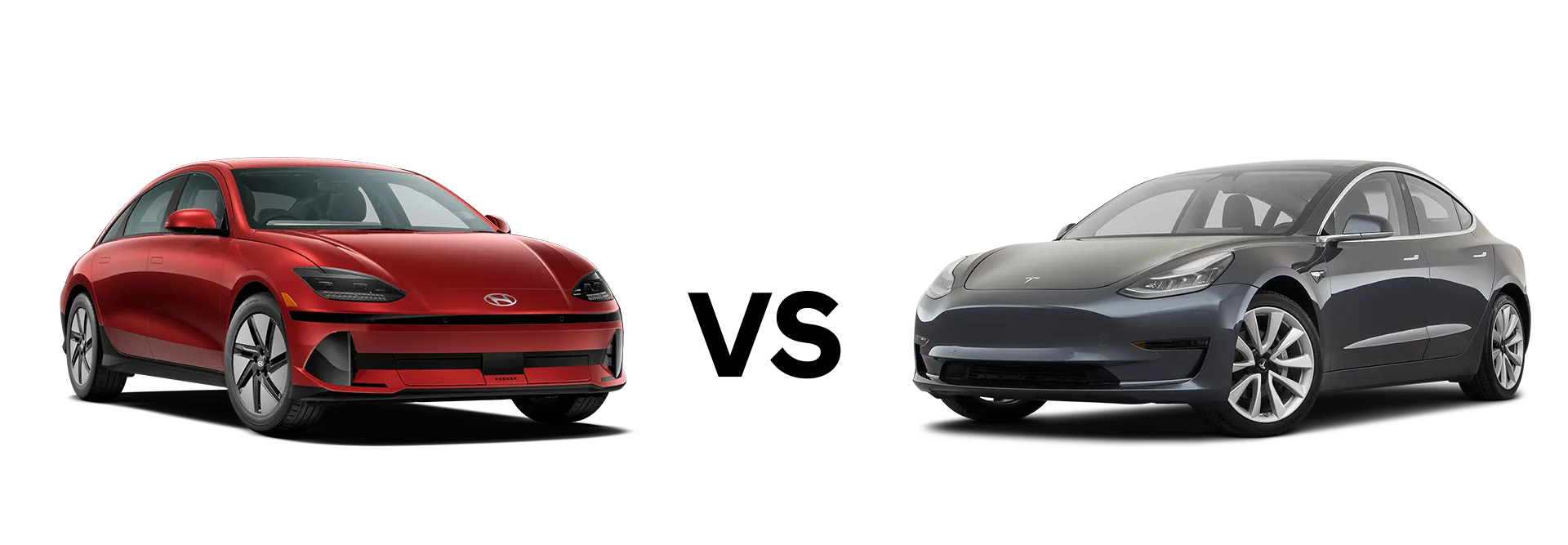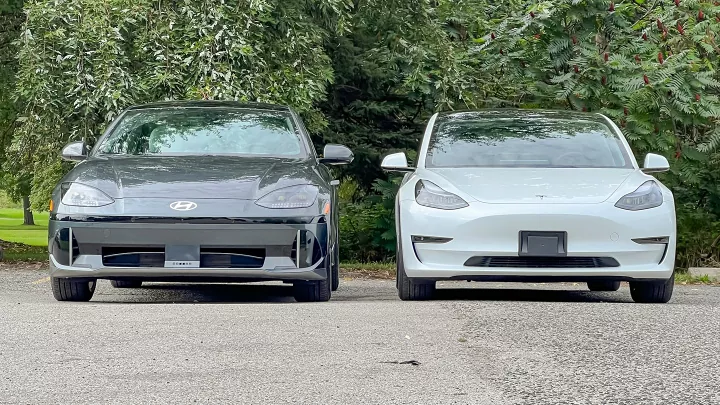Comparison: Tesla Model 3 vs Hyundai Ioniq 6 – Which Is Worth It?

Anúncios
The electric vehicle (EV) market is hotter than ever, and two sedans stand out: the Tesla Model 3 vs Hyundai Ioniq 6.
Both offer cutting-edge tech, impressive range, and sleek designs—but which one truly delivers the best bang for your buck?
This in-depth comparison dives into performance, technology, comfort, and value to help you decide.
Performance: Speed, Range, and Driving Dynamics
Tesla Model 3 – The Benchmark for Acceleration
Anúncios
Tesla’s Model 3 remains a performance leader, especially in its Dual Motor AWD and Performance trims.
The latter rockets from 0-60 mph in just 3.1 seconds, making it one of the quickest sedans at any price.
The low center of gravity and near-perfect weight distribution ensure sharp handling, though some critics argue the ride is overly stiff for daily comfort.
Moreover, Tesla’s extensive Supercharger network enhances the driving experience by providing convenient charging options during long trips.
This infrastructure allows Model 3 owners to travel further without the anxiety of running out of battery power.
Hyundai Ioniq 6 – Efficiency Meets Refinement
The Ioniq 6 counters with a 77.4 kWh battery and an EPA-estimated 361 miles of range (RWD model), slightly edging out the Model 3 Long Range’s 358 miles.
Hyundai’s 800V architecture enables ultra-fast charging—10% to 80% in just 18 minutes under optimal conditions.
While not as blisteringly quick as Tesla (0-60 mph in 5.1 seconds for the AWD version), it delivers a smoother, more refined ride, prioritizing comfort over track-ready aggression.
Additionally, the Ioniq 6’s regenerative braking system is designed to enhance efficiency and extend driving range.
This feature allows drivers to recover energy during braking, making every mile count.
Performance Comparison Table
| Feature | Tesla Model 3 (Performance) | Hyundai Ioniq 6 (AWD) |
|---|---|---|
| 0-60 mph | 3.1 seconds | 5.1 seconds |
| Top Speed | 162 mph | 115 mph |
| EPA Range | 315 miles | 316 miles (AWD) |
| Charging (10-80%) | ~25 minutes (250 kW) | ~18 minutes (350 kW) |
Technology: Infotainment, Autopilot, and Innovation
Tesla’s Minimalist Tech Dominance
Tesla’s 15.4-inch touchscreen is the nerve center of the Model 3, controlling everything from climate to Autopilot.
The system is intuitive but polarizing—there are no physical buttons, which can frustrate some drivers.
Full Self-Driving (FSD) remains controversial, yet its over-the-air updates keep improving features like Navigate on Autopilot and Smart Summon.
Tesla’s commitment to software updates ensures that the vehicle remains at the forefront of technology.
This continuous improvement model allows owners to benefit from enhancements without needing to visit a service center.

Hyundai’s Balanced Approach
Hyundai offers a dual 12.3-inch screen setup (digital cluster + infotainment) with Apple CarPlay and Android Auto—features Tesla still refuses to include.
The Highway Driving Assist 2 (HDA 2) system isn’t as advanced as FSD but provides reliable lane-keeping and adaptive cruise control.
Where Hyundai shines is vehicle-to-load (V2L), allowing the Ioniq 6 to power external devices—a perk Tesla lacks.
This feature makes the Ioniq 6 a versatile choice for outdoor activities or emergencies, offering practical utility.
Additionally, Hyundai’s infotainment system is user-friendly and offers a wide range of customization options.
This flexibility can enhance the overall driving experience, making it more enjoyable for various users.
+ Tesla Model Y vs Ford Mustang Mach-E: Electric Cars Face Off
Design & Comfort: Futuristic vs. Functional
Tesla’s Polarizing Minimalism
The Model 3’s cabin is a study in simplicity—some say too simple.
The lack of buttons and a sparse interior may appeal to tech enthusiasts but leave others wanting more luxury.
Recent updates have improved materials, but road noise remains a common complaint.
Furthermore, the minimalist design can create a sense of spaciousness, which many drivers appreciate.
However, some consumers find the absence of tactile controls disorienting and less engaging.
Hyundai’s Premium Ergonomics
The Ioniq 6 embraces a retro-futuristic aesthetic, with flowing lines and an upscale cabin featuring sustainable materials.
Sound insulation is superior, and the available relaxation seats (with leg extensions) make long drives more comfortable.
Hyundai has also focused on ergonomics, ensuring that controls are within easy reach and intuitive to use.
This attention to detail enhances the overall driving experience, especially on longer journeys.
Moreover, the ambient lighting and customizable interior features contribute to a more luxurious feel.
Interior & Comfort Comparison Table
| Feature | Tesla Model 3 | Hyundai Ioniq 6 |
|---|---|---|
| Infotainment Screen | 15.4-inch (single) | Dual 12.3-inch |
| Apple CarPlay/Android | No | Yes |
| Cabin Noise | Moderate | Well-insulated |
| Unique Feature | Over-the-air updates | Vehicle-to-load (V2L) |

++ Toyota Corolla vs Honda Civic: Which Is the Best Sedan?
Pricing & Value: Which One Makes More Sense?
Tesla’s Aggressive Pricing (With Caveats)
The Model 3 starts at $40,630 (after federal tax credits), undercutting the Ioniq 6’s $42,450 base price.
However, adding FSD ($12,000) or opting for higher trims quickly escalates costs.
In contrast, the Ioniq 6 offers a more straightforward pricing structure with fewer costly add-ons.
This transparency can make budgeting for a new vehicle easier for potential buyers.
Additionally, Hyundai frequently runs promotions and incentives that can further reduce the overall cost.
Hyundai’s Strong Warranty & Incentives
Hyundai offers a 10-year/100,000-mile battery warranty, dwarfing Tesla’s 8-year/120,000-mile coverage.
Some states also provide additional EV incentives, further sweetening the deal.
This robust warranty reflects Hyundai’s confidence in its product quality and reliability.
Moreover, the extensive service network ensures that customers receive support when needed.
For those considering long-term ownership, these factors can significantly enhance the vehicle’s value proposition.
Final Verdict: Who Wins the Tesla Model 3 vs Hyundai Ioniq 6 Battle?
If performance and tech innovation are your priorities, the Tesla Model 3 is hard to beat.
But if you value comfort, charging speed, and a more traditional luxury feel, the Hyundai Ioniq 6 is the smarter choice.
A 2023 J.D. Power study found that Hyundai ranks higher in dependability than Tesla, which may sway buyers seeking long-term reliability.
Ultimately, your decision hinges on whether you prefer Tesla’s cutting-edge ethos or Hyundai’s balanced refinement.
Which one would you pick? Let us know in the comments!
